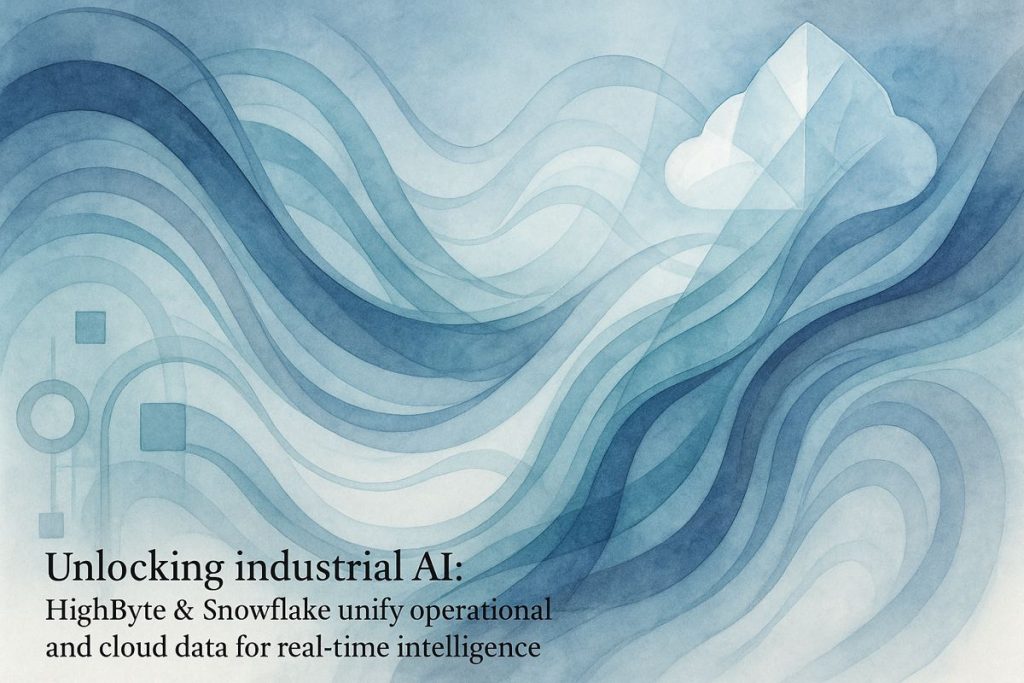The partnership between HighByte and Snowflake makes it much easier for factories to use their data. HighByte cleans and organizes data right where machines work, then sends only the important, ready-to-use information to Snowflake’s cloud. This means companies can see what’s happening in real time, fix problems faster, and follow rules more easily. Big names like Lindt (the chocolate maker) and car companies are already using this to make better decisions and speed up their work. It’s like waking up sleepy factory data so it can actually help run things smarter.
How does the HighByte and Snowflake partnership improve industrial data management?
The HighByte and Snowflake partnership streamlines industrial data management by contextualizing and normalizing data at the edge with HighByte, then delivering AI-ready information directly to Snowflake’s Data Cloud. This enables real-time analytics, closed-loop automation, improved compliance, and faster digital transformation for industries like life sciences, pharma, and automotive.
The Data Factory Floor: Where the Real Drama Happens
I’ve always thought of the shop floor as a kind of palimpsest—a layered manuscript, scribbled over the years with data, grease, and the occasional curse muttered under one’s breath. In 2025, with AI’s appetite for data swelling like a sourdough starter left overnight, companies in life sciences, pharmaceuticals, and automotive are suddenly scrambling to unearth meaning from every last sensor ping. Who can blame them? In this atmosphere, the partnership between HighByte and Snowflake reads less like a press release and more like a gear finally clicking into place—one that might actually keep the machinery humming.
Let’s be honest: for decades, the average PLC, SCADA system, or industrial historian (hello, Wonderware and Siemens SIMATIC) was the social outcast at the data party, speaking in cryptic dialects nobody at headquarters could understand. Data was captured—sometimes even archived with the zeal of an over-caffeinated librarian—but rarely did it escape the gravity of the plant walls. I’ve seen teams try to build bridges with brittle scripts and spreadsheets, only to watch them collapse on the first shift change…
I had to ask myself: is it really possible to stitch OT and IT together without creating a Rube Goldberg contraption? HighByte and Snowflake seem to think so, and for once, the technical specifics aren’t just marketing smoke.
HighByte Intelligence Hub: A Sensory Overhaul at the Edge
Enter the HighByte Intelligence Hub. Not just another DataOps platform with a coat of industrial paint—this is more like an airlock for your data, scrubbing and synchronizing it before sending it off-world. Imagine a hyperspectral scanner: HighByte contextualizes, normalizes, and models data at the edge, right as it emerges from the machine’s “heartbeat.” There’s a tactile satisfaction there—almost like running your fingers along the cool, ridged surface of a fresh circuit board.
Before I go off on a sensory tangent, let’s get concrete. HighByte runs natively on Linux, Windows, Docker, and Kubernetes (I once installed it on a Raspberry Pi—don’t ask, it wasn’t pretty). But that flexibility means you can deploy it wherever you need: in a single sterile pharma lab or scattered across a sprawling multinational like Bosch. And here’s the kicker: data isn’t just moved, it’s refined. Only the right, “AI-ready” bits are piped to the Snowflake Data Cloud, slashing the laborious ETL rituals that used to haunt analytics teams HighByte News: Native Connectivity to Snowflake.
The moment I realized the practical benefit—no more endless, manual spreadsheet cleansing—I felt an odd surge of relief. Maybe even (dare I say?) hope.
The Snowflake Leap: Real-Time Streams and Closed Loops
Now, if you haven’t kept up: late 2024 saw HighByte Intelligence Hub 3.3 drop two native Snowflake connectors. This is the “aha!” moment, trust me. First, there’s the Snowflake Streaming Connector, which taps into Snowpipe Streaming API. Real-time, low-latency data flow—so fresh you can practically hear the hum of conveyor belts in the cloud as data lands in Snowflake tables. Forget the old batch jobs that felt like waiting for paint to dry.
Then there’s the Snowflake SQL Connector. This one closes the loop—literally. You can now query Snowflake insights and shove results right back to the shop floor, letting AI findings trigger immediate actions: think maintenance nudges or process tweaks delivered before the next shift’s coffee break HighByte-Snowflake Solution Brief (PDF). It’s not quite HAL 9000, but it does let the cloud whisper back to the machines.
When I demoed this to a skeptical team, watching a predictive model flag an anomaly and have that insight pop up in the plant dashboard—bam!—I actually grinned. Not cool, but true.
From Chocolate to Compliance: Tangible Industry Shifts
This isn’t just theory. Lindt & Sprüngli, the chocolate folks, threw their weight behind the HighByte-Snowflake combo. The result? Faster digital transformation and sharper quality control—data from mixers and quality labs stitched together in real-time, like a chocolatier folding ganache. Sweet, literally.
Regulated industries—hello, GxP pharma—crave audit trails and normalized data. With HighByte prepping the data before it lands in Snowflake, compliance teams get their golden thread: lineage, context, and fewer audit headaches. I once botched a compliance report by overlooking a timestamp mismatch; if I’d had this stack, I might’ve saved myself a week of stress and at least three hazelnut lattes.
AWS has even published guidance on building unified industrial data fabrics using HighByte and Snowflake together. The upshot? Less time wrangling, more time mining insight. Could this be the elusive data fabric we’ve been promised since the days of dusty mainframes?
The Zeitgeist: AI Mania and Real-World Proof
Here’s what’s fascinating: Snowflake’s AI Data Cloud is now a hotbed for industrial innovation. Companies like CarMax and Nissan are tapping into unified data streams to drive everything from predictive maintenance to new product launches.
